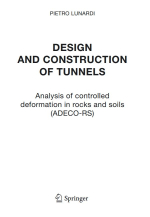Добрый день, Коллеги. Важное сообщение, просьба принять участие. Музей Ферсмана ищет помощь для реставрационных работ в помещении. Подробности по ссылке
Design and construction of tunnels. Analysis of controlled deformation in rocks and soils (ADECO-RS) / Проектирование и строительство туннелей. Анализ контролируемых деформаций в горных породах и грунтах (ADECO-RS)
Geological hazard and the lack of appropriate survey, design and construction instruments for tackling those terrains we call “difficult”, with good prospects of success, have always made the design and construction of underground works a risky affair, which could not therefore be faced with the same degree of accuracy as other civil engineering works. As a consequence they have always occupied a subordinate position with respect to similar surface constructions and in the past they were only resorted to when the latter seemed impractical or of little use.
However, decisive progress made in the field of geological surveys, the availability of powerful computers for making calculations and above all the introduction of excavation technologies that are effective in all types of ground have created the conditions for a qualitative quantum leap forward. The last formidable negative factor to be overcome to achieve that transparency in this field, which has until now been the prerogative of traditional surface works, remains the absence of a modern and universally valid design approach, capable, that is, of integrating and exploiting the new capabilities and of guiding the design engineer through the stages of design and construction. In fact even today the answer to the apparently obvious and banal question, “What does the design and construction of an underground work consist of?”, would find many design engineers in disagreement not only on the form but also on contents of design. And this is not surprising because this type of problem has always been addressed in a very indeterminate fashion. Until not very long ago the inadequacy of the available knowledge and means meant that the design of an underground construction had to be improvised during tunnel advance. As a consequence, the design of such a construction was merely a question of identifying the geometry of the route and some of the tunnel section types, while the means of excavation, intervention to stabilise the tunnel and which linings to use were largely decided during construction as the tunnel advanced <...>




